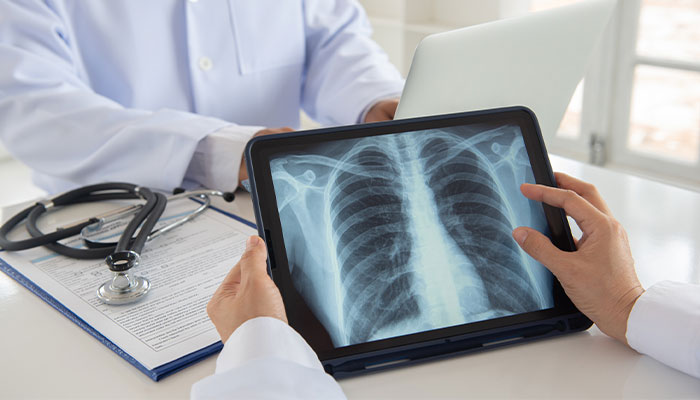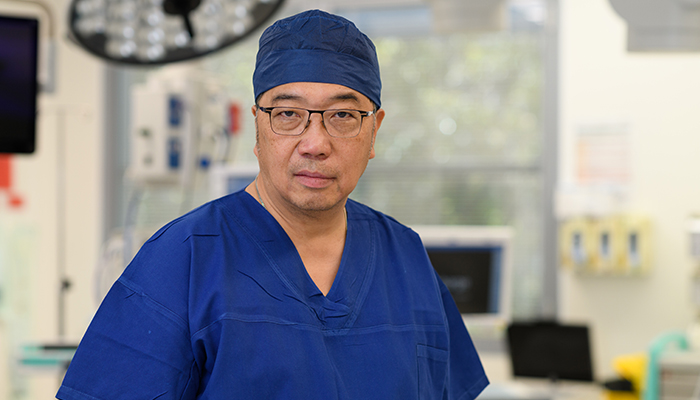As with all types of cancer, speed is of the essence in diagnosing and treating lung cancer.

While it is only the fifth most commonly diagnosed cancer in Australia, it is the leading cause of cancer death, with fewer than one person in five surviving for five years after diagnosis.
One of the earliest, and most treatable, indications of the disease is one or more pulmonary nodules.
These small lesions are up to 3cm across, and show up on chest X-rays and CT scans as spots in the air spaces of the lungs. Some are not cancerous, but others may signal Stage 1 lung cancer.
By the time someone has the serious symptoms we associate with lung cancer, such as pain, coughing up blood or breathlessness, the spread has often gone too far for us to treat.
Macquarie University Professor of Respiratory Medicine, Professor Alvin Ing, said pulmonary nodules were often detected through routine procedures such as chest X-rays and CT coronary angiograms.
“At this early stage, the patient is likely to be asymptomatic,” he said.
“By the time someone has the serious symptoms we associate with lung cancer, such as pain, coughing up blood or breathlessness, the spread has often gone too far for us to treat.
Expert team assembled
“Our new clinic at Macquarie University Hospital is the first of its type in NSW and one of only two in Australia,” Ing said.

Early diagnosis: Smokers over the age of 50 are at the highest risk of developing lung cancer.
“Traditionally, when nodules are detected, the person’s GP refers them to a respiratory physician, but this can take time.
“We aim to see people within 10 working days. When they come to us, we assemble a multidisciplinary team led by one of our 12 respiratory physicians many of whom are interventional pulmonologists. The team also includes radiologists, cardiothoracic surgeons, radiation oncologists, medical oncologists, primary care practitioners, and the patient’s own GP.
“Together, we classify the type of nodules the person has, carry out an individual evidence-based clinical risk assessment, then develop a treatment plan.”
With minimally invasive, robotically-assisted thoracic surgery, patients can be treated and out of hospital in just a few days.
Ing said with the latest technology, patients could be diagnosed with greater accuracy and treated in ways that reduced both the amount of time they needed to spend in hospital and their recovery period.
“Using advanced imaging equipment, we measure the volume of a nodule rather than just its diameter, a process that gives us a more accurate indication of its size and whether that is changing over time,” he said.
“It might be difficult to tell whether a nodule is growing by measuring it in two dimensions, which can vary, but if its volume increases significantly, then it’s highly suspicious of a lung cancer and warrants further investigation and treatment.
Less invasive treatment options
“Traditionally, a patient has required an open thoracotomy to remove nodules. This is significant surgery that can require up to seven days in hospital, with a period of recovery afterwards.

Steps forward: Professor Alvin Ing says with the latest technology, patients could be diagnosed with greater accuracy.
“But with minimally invasive, robotically-assisted thoracic surgery, patients can be treated and out of hospital in just a few days. Another treatment option, SABRE radiotherapy, allows us to target the tumours precisely, reducing the area affected by radiation and therefore the side effects.
“The multidisciplinary approach combined with the latest techniques and equipment means patients can be treated and begin their recovery as soon as possible.
“We have already begun a database to measure the outcomes of the clinic, to see whether it is not only a faster and better way of managing early-stage lung cancer for patients, but also more cost-effective for the health system.”
Smokers over the age of 50 are at the highest risk of developing lung cancer, with people in the Aboriginal and Torres Strait Islander community, and those living in remote or socioeconomically disadvantaged areas disproportionally affected.
In order to combat this, Cancer Australia has begun scoping for a potential screening program for people at high risk of developing lung cancer, similar to successful programs already in place for bowel, breast and cervical cancers.
If this screening program is introduced, it is estimated that about 70 per cent of lung cancers could be identified at an early, treatable stage, significantly improving the five-year survival rate.
(pictured) is a Professor in Respiratory Medicine in the Department of Clinical Medicine, Macquarie University.







